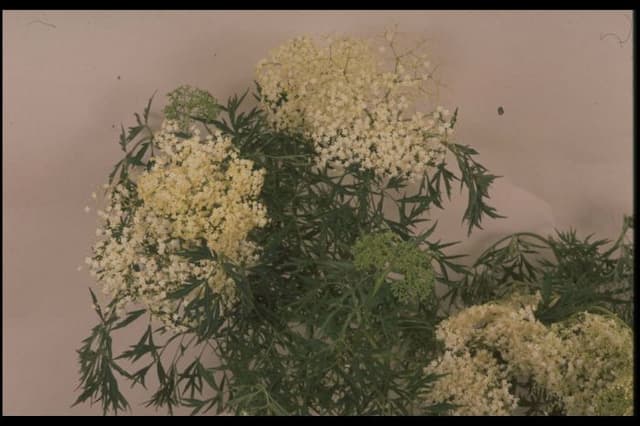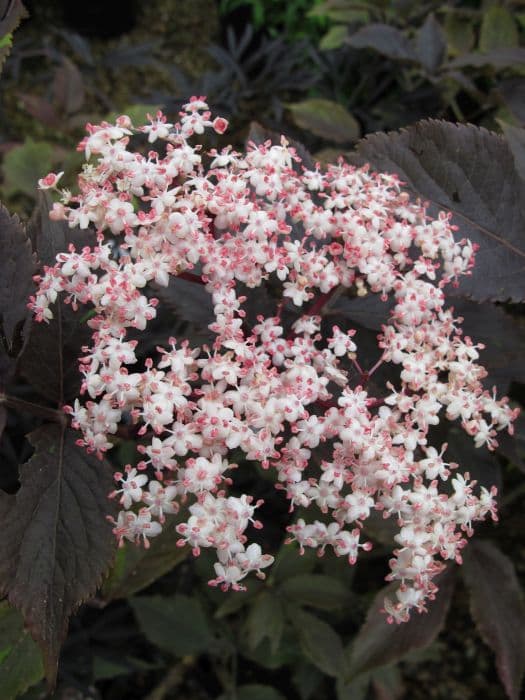Japanese Snowball Viburnum plicatum f. tomentosum 'Lanarth'

ABOUT
The Viburnum plicatum f. tomentosum 'Lanarth', commonly known as Japanese snowball, is a highly ornamental plant noted for its distinct decorative features. It showcases layers of horizontal branches that give it a tiered, almost pagoda-like structure. This pattern is a striking visual characteristic, providing a sense of elegance and symmetry. The leaves of the Japanese snowball are dark green, deeply veined, and have a textured, pleated appearance. They present a dramatic backdrop to the plant's flowers, which are among its most delightful attributes. The blooms are arranged in lacecap-style clusters, with a ring of large, showy, sterile flowers encircling a center of smaller, fertile flowers. The flowers are typically white and they emerge in abundance, covering the plant in a snowy display that can resemble fluffy balls of cotton. As the seasons change, the Japanese snowball's leaves transform, displaying beautiful autumn colors that range from reds to purples, adding a new dimension to its ornamental value. In addition to its foliage and floral display, the plant may produce red fruit that matures to black, providing visual interest and attracting wildlife. Overall, the Japanese snowball presents a harmonious blend of structured growth habit, lush foliage, prolific flowering, and seasonal color changes, making it a beloved choice for gardeners seeking an eye-catching shrub.
About this plant
 Names
NamesFamily
Adoxaceae
Synonyms
Japanese Snowball, Doublefile Viburnum, Lanarth Viburnum
Common names
Viburnum plicatum var. tomentosum 'Lanarth'.
 Toxicity
ToxicityTo humans
The Japanese Snowball is not considered highly toxic to humans. However, it may contain mild toxins that can cause stomach upset if ingested in large quantities. Symptoms of ingestion can include nausea, vomiting, and diarrhea. It is generally advisable, as with many ornamental plants, to avoid consuming any parts of this plant.
To pets
The Japanese Snowball is generally not regarded as highly toxic to pets. If ingested, it might cause mild gastrointestinal upset, similar to humans. Symptoms of ingestion in pets might include vomiting, diarrhea, and abdominal discomfort. Nevertheless, it's always best to prevent pets from eating ornamental plants as a precautionary measure.
 Characteristics
CharacteristicsLife cycle
Perennials
Foliage type
Deciduous
Color of leaves
Green
Flower color
White
Height
8-10 feet (2.4-3 meters)
Spread
6-8 feet (1.8-2.4 meters)
Plant type
Shrub
Hardiness zones
5
Native area
Japan
Benefits
 General Benefits
General Benefits- Ornamental Appeal: The Japanese Snowball 'Lanarth' is known for its beautiful, showy blooms that enhance the aesthetic of any garden.
- Seasonal Interest: It provides year-round interest with flowers in spring, berries in summer, and colorful leaves in fall.
- Attracts Wildlife: The plant's flowers can attract pollinators such as bees and birds, enriching the local ecosystem.
- Low Maintenance: Once established, it requires minimal care, making it suitable for gardeners of all skill levels.
- Drought Resistance: 'Lanarth' is relatively drought-tolerant, reducing the need for frequent watering once it's well-established.
- Privacy Screen: Its dense growth habit can be used to create privacy screens or hedges in landscapes.
- Soil Adaptability: 'Lanarth' can adapt to a variety of soil types, though it prefers well-drained soils.
- Cold Hardy: This variety is cold hardy, making it suitable for gardens in cooler climates.
 Medical Properties
Medical Properties- This plant is not used for medical purposes.
 Air-purifying Qualities
Air-purifying QualitiesThis plant is not specifically known for air purifying qualities.
 Other Uses
Other Uses- Viburnum plicatum f. tomentosum 'Lanarth', commonly known as Doublefile Viburnum, can be used in floral arrangements due to its attractive flowers and structured form.
- The dense foliage of Doublefile Viburnum provides excellent cover for birds and small wildlife seeking shelter and nesting sites.
- Its berries, while not widely regarded as edible for humans, can serve as a food source for birds during the fall season.
- The wood of Doublefile Viburnum is sometimes used in small woodworking projects or for creating artistic natural sculptures.
- In larger gardens, these plants can be used as natural screens or hedges to divide sections or create privacy without the need for fences.
- The symmetrical branching pattern of Doublefile Viburnum is occasionally used as a study subject for photography and botanical illustration.
- Cultural symbolism: In some cultures, the plant may be used as a symbol in rituals or ceremonies, especially signifying growth and renewal.
- Landscape photography: Gardeners and landscapers often utilize the plant as a backdrop in garden photography due to its picturesque flowering.
- Educational use: Horticulture programs may use Doublefile Viburnum for teaching plant pruning techniques because of its pronounced branch structure.
- Leaf casting: Crafters might use the textured leaves of Doublefile Viburnum to create decorative leaf castings for garden ornaments or artwork.
Interesting Facts
 Feng Shui
Feng ShuiThe Doublefile Viburnum is not used in Feng Shui practice.
 Zodiac Sign Compitability
Zodiac Sign CompitabilityThe Doublefile Viburnum is not used in astrology practice.
 Plant Symbolism
Plant Symbolism- Renewal: The Doublefile Viburnum is known for its ability to rejuvenate itself, often flowering and bearing fruit each season, symbolizing the idea of renewal and new beginnings.
- Protection: With its robust branching and dense foliage, Doublefile Viburnum may serve as a natural shelter for birds and wildlife, thus symbolizing safety and protection.
- Connection: The interlacing branches of Doublefile Viburnum can also be seen as a symbol of interconnectedness and the importance of relationships in the natural world.
 Water
WaterThe Japanese Snowball (Viburnum plicatum f. tomentosum 'Lanarth') prefers consistently moist soil, so it should be watered deeply once a week, allowing the water to soak into the ground rather than just wetting the surface. On average, use about 1 to 2 gallons of water per week, depending on the size of the plant and the weather conditions. During dry spells or hot weather, you might need to water twice a week. Make sure not to oversaturate the soil, which can lead to root rot. It's important to water the plant at the base to keep the leaves dry and prevent fungal diseases.
 Light
LightThe Japanese Snowball thrives in areas that receive full sun to partial shade. The ideal spot will provide at least four to six hours of direct sunlight a day, with some protection from the intense afternoon sun, especially in hotter climates. A location that gets morning sun and afternoon shade is often optimal, ensuring that the plant has enough light without being exposed to potential leaf scorch.
 Temperature
TemperatureThe Japanese Snowball is hardy and can endure temperatures as low as -10°F and as high as 95°F, but it performs best in temperate climates. Ideal growing temperatures range from 60°F to 75°F. This plant is winter-hardy to USDA zones 5 through 8; sudden and extreme temperature fluctuations should be avoided to prevent damage.
 Pruning
PruningPruning the Japanese Snowball should be done for shaping, to remove dead or broken branches, and to encourage a strong plant structure. The best time for pruning is late winter or early spring, before the onset of new growth. This plant blooms on old wood, so minimal pruning is best to avoid cutting off flower buds. If a more extensive pruning is required, do it immediately after flowering to ensure blooms are not compromised for the following season.
 Cleaning
CleaningAs needed
 Soil
SoilDoublefile viburnum prefers moist, well-draining soil with a slightly acidic to neutral pH of 5.6 to 7.0. The best soil mix for this plant can be a blend of garden soil, compost, and peat moss or pine bark to ensure good drainage and fertility.
 Repotting
RepottingDoublefile viburnums are typically outdoor plants and do not require frequent repotting. They should only be transplanted or repotted if they outgrow their current location, which is infrequent and depends on their growing conditions.
 Humidity & Misting
Humidity & MistingDoublefile viburnum thrives in average outdoor humidity levels; it does not have specific humidity requirements. The plant is quite adaptable and can tolerate the humidity levels typically found in its hardiness zones.
 Suitable locations
Suitable locationsIndoor
Ensure bright, indirect light and room to grow.
Outdoor
Choose partial sun, well-drained soil, and space to spread.
Hardiness zone
5-8 USDA
 Life cycle
Life cycleThe life cycle of the Doublefile Viburnum, Viburnum plicatum f. tomentosum 'Lanarth', starts with germination, where after stratification, the seeds sprout when exposed to warm temperatures and sufficient moisture. Next, seedlings grow into juvenile plants, establishing a strong root system and beginning to develop characteristic leaves and branching patterns. As the plants reach maturity, they start to produce flowers, typically in spring, with distinctive horizontal branching that showcases the white blooms. Following pollination, usually by insects, these plants produce berry-like drupes which turn red to black when ripe, containing seeds for subsequent dispersal. The Doublefile Viburnum then enters a period of senescence as it ages, with older specimens showing reduced vigor and fewer flowers. Ultimately, the plant dies, completing its life cycle, and if seeds have been effectively dispersed and conditions are right, new plants will sprout, beginning the cycle anew.
 Propogation
PropogationPropogation time
Spring-Early Summer
The most popular method of propagation for Viburnum plicatum f. tomentosum 'Lanarth', commonly known as Japanese snowball, is through softwood cuttings. This technique is usually performed during late spring or early summer when the plant’s new growth is just beginning to mature and the stems are still soft and flexible. To propagate, a gardener would cut a 4 to 6-inch (10 to 15 cm) length of stem that includes at least two sets of leaves. The bottom set of leaves should be removed, and the cut end of the stem may be dipped in rooting hormone to improve the chances of successful root development. The prepared cutting is then placed in a pot with well-drained potting mix, ensuring that the soil remains moist but not waterlogged. With appropriate care, the cutting should root within a few weeks, at which point it can eventually be transplanted into the garden.









